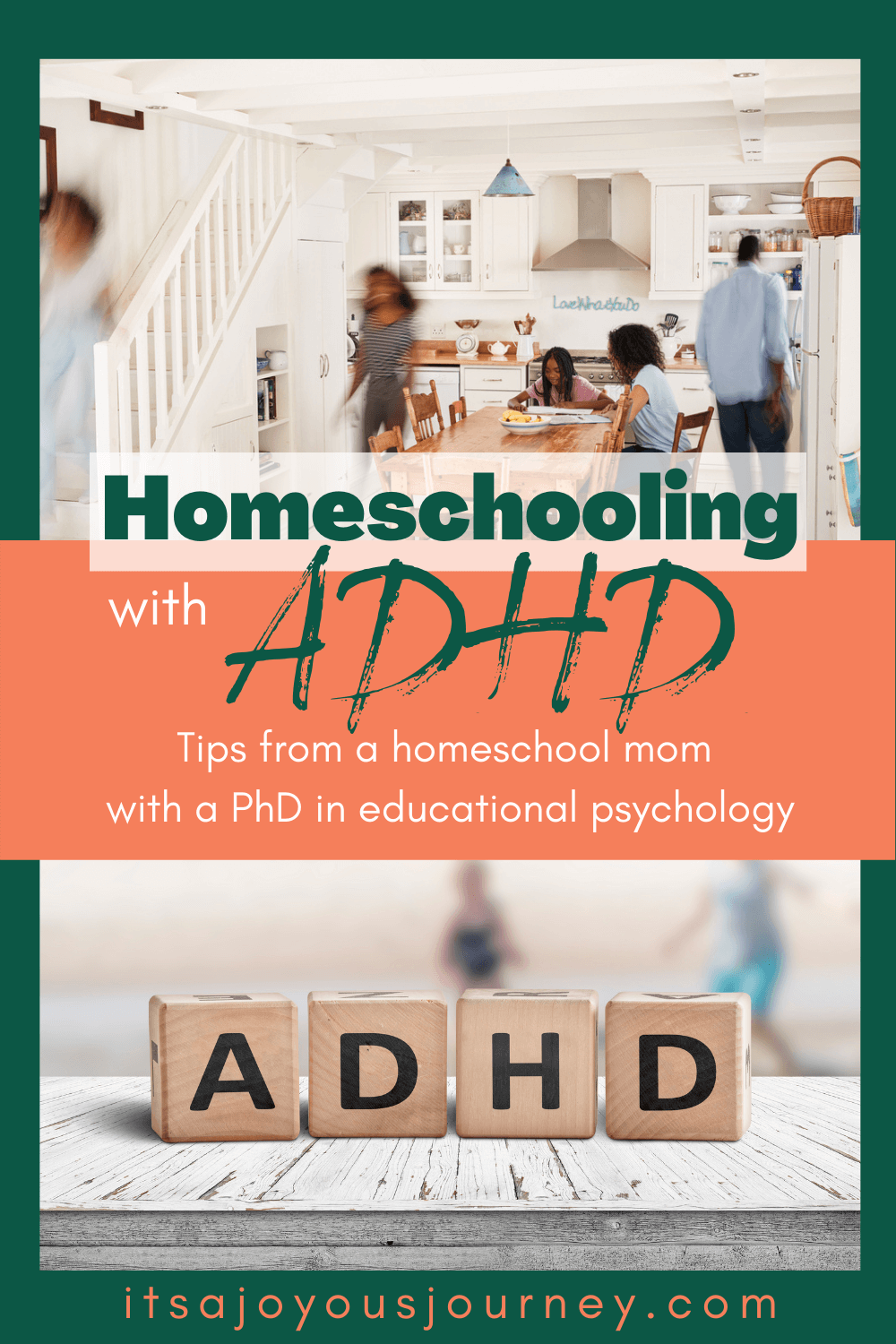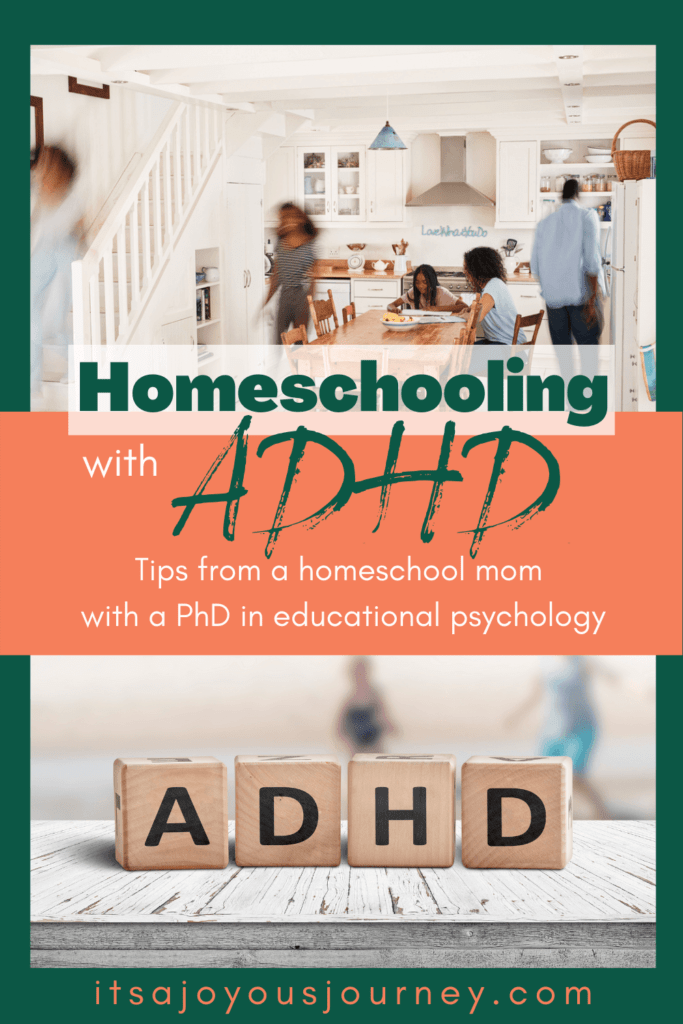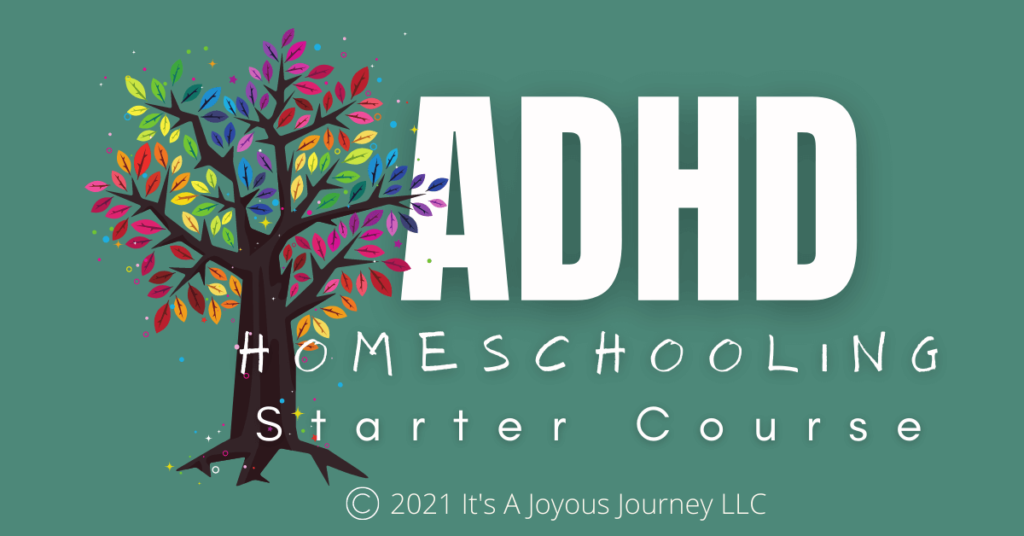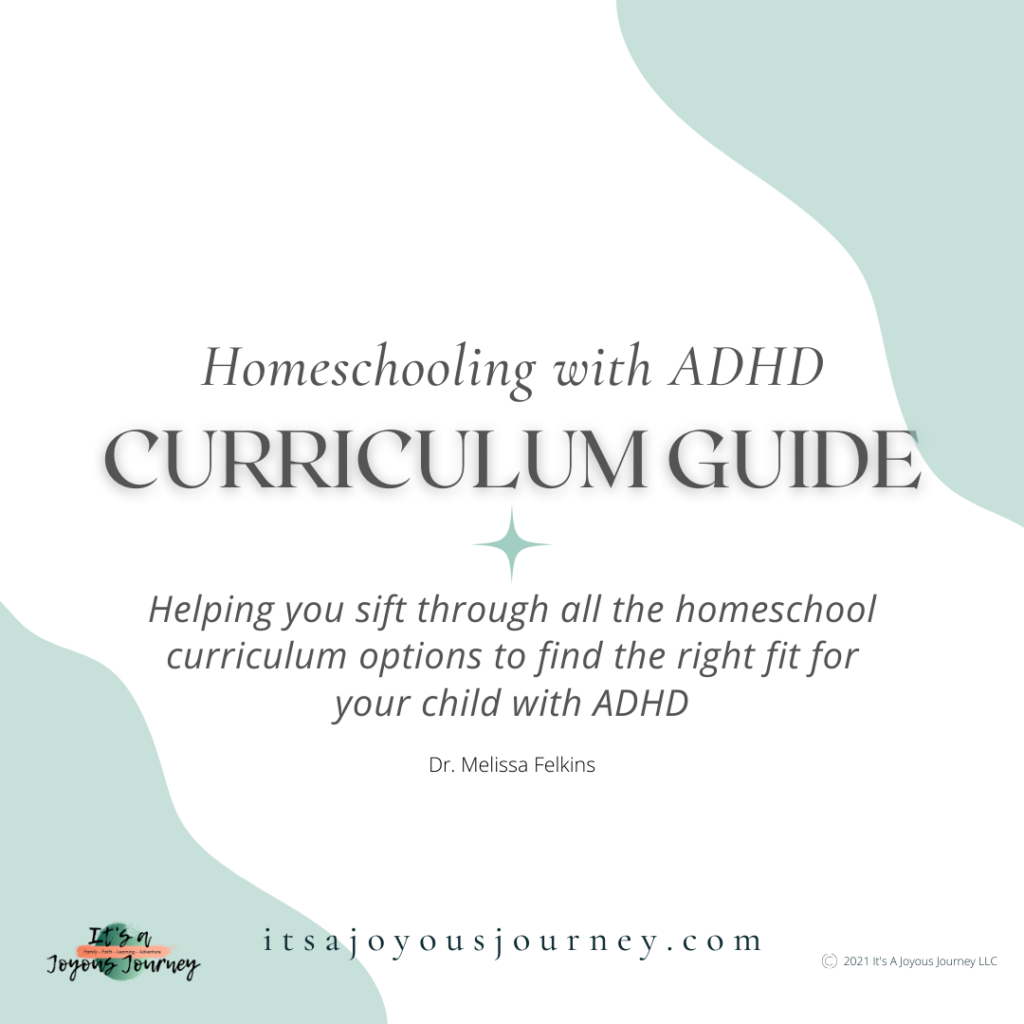Research-based tips for homeschooling with ADHD from a veteran homeschool mom who holds a Ph.D. in educational psychology.
This page may contain affiliate links from which we may earn a commission, at no additional cost to you, when you click and/or make a purchase from our partners. Sometimes, we also include links to external sites, from which we do not earn a commission. We have simply provided these links as a convenience to our readers. We make no claims and hold no responsibility for the content of the linked sites. See our Disclosure Policy for more information.
Pin for later…

Homeschooling with attention-deficit/hyperactivity disorder (ADHD) can be challenging for both students and parents, but it can also provide a learning experience that meets the individualized learning needs of these students in a unique and creative way!
The following tips are based upon my dissertation research study, “Experiences of Current or Former Homeschool Students Who Report ADHD Symptoms” (Felkins, 2018). This was the first study of its kind in which current and former homeschool students were interviewed to gain insight into their own perceptions of the experience.
Up to this point, I’ve always written on this subject in a very academic manner. It was the topic of my dissertation, after all. Now, I want to be able to share this information in a more personable way, so I am going to try really hard to tone down the academic nature and just talk to you parent-to-parent and teacher-to-teacher.
Note: My research participants were current and former homeschool students ages 12-21. These tips are based on perceptions from this age group. However, the general information can be applicable to students of any age.
Individualized Learning
The first thing to recognize is that all learners are different. Even among those with ADHD, there those who are hyperactive, those who are attention-deficient, and those who have a combination of these two types. The range of symptoms is significant, and it presents in varying ways throughout the population.
It’s important to take this into consideration when you are homeschooling a student with ADHD. What works well for one may not work well for another. With that being said, there were a few common threads that my participants thought were very important for their learning process.

Structured Flexibility
The most crucial tip I can give you about homeschooling a student with ADHD is to approach it with structured flexibility. These students need to have guidelines and boundaries, but flexibility is key.
Things don’t always go as planned. It might take longer to do an assignment, or you might realize that they are completely overwhelmed with the amount of information they are trying to process in one sitting.
That means it’s time to do something different! Take a break. Reduce the lesson into smaller chunks. Change the way you are approaching it. Move on to something else and come back to it later.
Remember, your homeschooling day doesn’t have to look just like a traditional school day!
Access all of my homeschooling with ADHD resources here!
Organization
One of the best things you can do for your children who are homeschooling with ADHD is to teach them strong organizational skills.
Forming Good Habits
If you, as a parent, are naturally good at being organized yourself, it may be frustrating when your child can’t seem to get things in order…especially if you’ve told them a thousand times. I know I’m sometimes guilty of spurting out a flurry of general instructions for things that come easily to me and just expecting others to know what I’m talking about.
Most kids with ADHD won’t respond well to that. They will just get overwhelmed and shut down. It’s better to give them small chunks of information…one or two steps at a time.
When you’re teaching organizational skills, you’re helping your kids to form good habits.
Start with one or two things at a time. Work on those skills until they become habits. Then, add in something new.
Does that mean you won’t ever have to go back and work on the previous skills you taught? Nope. You will most likely have to remind and re-teach some things over and over. But your effort will not be in vain. Some of it will stick. And those will be skills that will benefit your child for life!
Now, what if you are a parent who is not a naturally organized person? Thankfully, there are tools out there that will make you look like a pro and help you teach your kids good organizational skillls, too!
Online Homeschool Management
For my family, we use an online tool called Homeschool Planet to manage our homeschool. I plan the lessons by student, subject, and day, but I’m able to move them around when I need to in order to accommodate our flexible schedule.
My kids are able to sign into their own accounts, see what lessons are scheduled for the day, and mark them off as they complete them. This gives them the structure they need, and it really helps them to be able to see their progress as they complete their assignments each day.

My college kid has continued using this tool on his own to schedule out his coursework and keep him on track! He told me recently, “Mom, Homeschool Planet is the one thing in our homeschool that never changed.” We’ve used it since it first came out in 2013, and I wouldn’t want to homeschool without it!
They have a 30-day free trial, so you can try it out and see how you like it. The built-in lesson plans they offer now for many of the popular homeschool curriculum publishers make scheduling so effortless!
Even if you don’t use this tool, some other sort of checklist (even handwritten) can help tremendously! It can be so discouraging for a student to think they are done for the day and then find out they have more school work to do!
Schedule and Pacing
One big advantage of homeschooling is that students can work when they are at their best and can go at their own pace.
For teens, that might mean that you let them sleep a little later in the morning and do their school work later in the day. Younger kids might be ready to learn first thing in the morning.
It all goes back to individualized learning. Find what works best for each student and be willing to adjust as their needs change (remember the flexibility part?).
Give them choices
Does it really matter if they do math or English first? There might be circumstances where it does.
For instance, our family has a few things that we do together every day. If I don’t get them all in the same room to do those things before they start their individual lessons for the day, it’s almost impossible to get them back together again.
One finishes an assignment and is ready to do group stuff, but another has just started something and can’t join us at that moment…so the first goes and starts another assignment…then the other gets done with theirs and is ready for group stuff…but now the other one can’t do it…you get the picture.
Other than group work, though, my kids can choose for themselves the order in which they want to complete their work for the day. The older your kids get, the more control you can give them over their own schedule.
Even though students with ADHD may need a little more guidance to successfully navigate this freedom, it will help them learn necessary skills for self-discipline as they grow into adulthood.
The bottom line is to give them a framework to work within (structure), but then let them make some choices as to how to accomplish their goals (flexibility).
Let them go at their own pace
Going at their own pace is something the participants in my study mentioned over and over as a positive part of their homeschooling journey.
On the lessons/subjects that come easily to them, they are able to move quickly and get things done ahead of schedule. That leaves more time for the things that may prove to be a little more difficult.
If you don’t take the time to make sure they fully understand one thing before moving on to the next, it will create a snowball effect that will make future learning much more difficult for them. This can lead to emotional consequences that can severely cripple a student’s self-concept and desire to learn.
One-on-One Instruction
The participants in my study really valued the one-on-one instruction and support that they receive from their parents/teachers.

The homeschool experience allows for greater teaching flexibility to give students with ADHD the opportunity to have more intensive and explicit instruction to meet their individual learning needs.
This aspect of one-on-one instruction seems to be more important for younger students, as students often become more independent in their learning as they get older, especially if they have been taught solid organizational and research skills.
Older students, however, are more aware of the role emotional support from their parents plays in their overall success.
Change is OK
Don’t be afraid to make changes if something is not working.
Having the opportunity to work with your kids one-on-one gives you a front-row seat to their academic progress. If you and your student are overwhelmed because a certain curriculum is not working, take a good hard look at it.
Is there something you could do to modify it to better meet their needs? The worst thing you can do for any of your students is to become a slave to the curriculum. Believe me…I’ve done it…it’s not worth it!

Just because a certain schedule or particular assignments are suggested in a textbook doesn’t mean you have to make your students do exactly that. Maybe you need to decrease the number of math problems required each day, have them answer history questions out loud instead of writing them down, or ask them to teach a grammar lesson back to you. The important thing is that they learn the concept, not that they produce pages and pages of busywork.
And if you just absolutely can’t make the curriculum work, change it! I know this is not something to take lightly. Curriculum is expensive, and you work so hard to choose just the right one.
But if you hit a brick wall, and everyone involved is miserable, don’t submit your kids and yourself to months of struggle just to stick with a particular curriculum. You can usually find used curriculum online or at book sales, and you can re-sell the one that didn’t work for you. It will probably work great for someone else!
Focusing Tools
Here are a couple of things to think about regarding students who are homeschooling with ADHD. We often associate ADHD with hyperactivity, but we can’t forget about inattentiveness.
Inattentiveness often causes more distractions during school time than hyperactivity. Something else that we, as parents and teachers, may not be able to see is brain hyperactivity. Students with ADHD often struggle with internal focus.
While trying to do school work, their brains may become easily distracted by something else while they’re studying and spiral into a funnel of thoughts.
For example, one of my participants described how she might come across a word while she was reading that would remind her of a movie, which would remind her of a song, which would remind her of an artist, and so on.
I heard these types of stories over and over. Before they know it, a good amount of time has passed and they haven’t gotten any work done.
So what are some tools students who homeschool with ADHD can use to help maintain focus?
Music
Music is a great focus tool for many students. For most, instrumental music is the best choice, as music with words can often cause distractions.
With that being said, I did have one participant who said when she listened to music with lyrics while studying, she could recall the information when she heard the song again.
I have often found my son, who is a guitarist, picking a tune on the guitar while listening to an online lecture on his headphones. He’s providing his own background music and keeping his hands busy at the same time!
Finding the right tools for each student can take some trial and error. You always have to remember that individualized learning for students with ADHD includes finding individualized learning and focus tools.
Content Connection
Another tool homeschooling parents can use to increase engagement for their students with ADHD is to connect the content to the student’s interest. No, this is not going to be possible for every lesson in every subject.
However, my participants reported a much higher level of engagement in their course work when they were able to choose topics of interest when writing papers or doing research projects.
Be creative with this! If a student loves to play computer games, find educational computer games for them to play (by the way, many students with ADHD learn better this way).
One of my kids is like a sponge when he watches documentaries, while the other two usually fall asleep if I make them watch one. Those two love to listen to me read books, though (yes, even as teenagers).
Bonus:
Keep reading to your kids (even teens)!
Choose books that relate to the content your family is learning. Historical fiction is my favorite!
We’ve also had a lot of success with book series over the years.
We’ve done Chronicles of Narnia, Lord of the Rings, Anne of Green Gables, Percy Jackson, and Little House on the Prairie, to name a few.
Book series are great for keeping your kids’ interest!
They are always eager to start the next book and find out what happens next!
Don’t love to read aloud? Audio books can be your best friend!
Audio Books
Several participants in my research study mentioned that audio books are really important to them.
Different students will benefit from audio books in different ways. For some, it will help them to be able to accomplish more in a shorter period of time.
For others, it will help them to focus more on the content of the reading, rather than on the act of reading. That leaves more brain power and energy to process the information.
Most online curricula programs have an option for any written portions to be read aloud to the student. One of my own sons has always taken advantage of this option when it has been available.
It is especially exciting that many homeschool curriculum publishers are now offering their texts as audio books!

Movement
For your students who struggle with focus, let them have something to do to keep their hands busy while listening-coloring, puzzles, building blocks, clay, etc.
My kids are teens, but you’ll often see them coloring a map that corresponds to the book we’re reading, painting a picture, doodling, playing quietly with the dog, eating breakfast, or playing a game of checkers while I’m reading to them.
They can often absorb the information better if they are doing something other than just sitting and trying to focus completely on what you are reading. Just make sure that what they are doing is not distracting others who are trying to listen or you, as the reader. There are lots of options that will work for everyone and promote individualized learning.
Learning Environment
Another consideration for students who are homeschooling with ADHD is their learning environment.
Comfort
Some of my participants said they prefer to work in a place that is a little less comfortable (such as at a table or desk) because being uncomfortable helps them stay focused on getting their work done more efficiently.
Others, however, reported that being uncomfortable creates even more of a distraction for them, so they prefer to sit on a couch, bean bag, or even their beds.
This is something that parents really need to communicate about with their kids and help them modify their environment to find the most productive scenario.
External Distractions
Another important aspect of the learning environment that should be considered is external distractions.

If you’re insisting that your kids all stay in one area to complete all of their lessons, you may be contributing to the lack of focus for your student with ADHD.
Siblings or other household noises and activity can easily take a student’s attention from their work, and they may have a very hard time re-focusing.
If this is a problem for your student, consider allowing them to work in an area with fewer distractions or use headphones with instrumental music to drown out the noise.
I realize it’s easier to keep an eye on everyone if you have them all in the same area, but it might not be what is best for your student with ADHD. Be willing to make adjustments and be flexible, so your students can have the best opportunity at achieving academic success.
Bottom Line
Structured flexibility should be the backbone of the individualized learning experience for students who are homeschooling with ADHD. Take a look at these four elements and see how you can manage them in the best way to help your students be successful:
- Schedule and Pacing
- One-on-One Instruction
- Focusing Tools
- Learning environment
Access all of my homeschooling with ADHD resources here!
What questions do you have about homeschooling with ADHD?
Pin For Later…

References
Felkins, M. (2018). Experiences of Current or Former Homeschool Students Who Report Adhd Symptoms (dissertation). ProQuest.




Lisa
Great ideas! Thank you for sharing.
Melissa F
Thanks for reading!
Ruth Iaela-Pukahi
You’ve given some really great advice! As an Elementary Librarian Teacher, I always swore I’d never homeschool my kids but after our current stay home situation, it may be something I’d consider doing. Our family life seems more flexible to do different things. Time is just different. So many things to think about. Like you said, homeschool is flexible. I like that…though maybe I can enroll my kids in school just during their favorite sport season. heehee
Melissa F
I am actually a former public school teacher and counselor and never thought I’d homeschool my kids either! A lot of my homeschool mom friends used to teach in traditional classrooms as well. It just offers a completely different lifestyle and is flexible to meet the individualized needs of learners. You might check with your local homeschool organizations to see what kinds of sports are offered for homeschool students. Here in OKC, we have very competitive sports organizations, as well as band, choir, and a host of other extracurriculars. Keep me updated with what you decide to do!
Melissa Jones
Great tips!
Melissa F
Thanks!
Tara Hallie
Such wonderful suggestions for anyone homeschooling a child with needs. Thank you for sharing!
Melissa F
Thanks for reading!
Tiffany
These are great tips and love the resources – hoping a few of these help a bit as we transition to our homeschooling routine!
Melissa F
Thank you! Good luck with your routine!
heather J jandrue
Excellent tips. My son has ADND and we are in the midst of e-learning. I need some help with how to help him.
Melissa F
I hope some of the tips work for you!
Kendra
I wish I knew more about this when my oldest was younger. Although never diagnosed, I’m pretty sure she had ADD and still does as an adult.
Melissa F
We’re learning more and more that it’s not something that people grow out of, as used to be thought. I hope she has found ways to manage her symptoms.
Azalee
A wonderful article that I have shared.
Melissa F
Thanks!
Alice
Very informative.
Melissa F
Thanks!